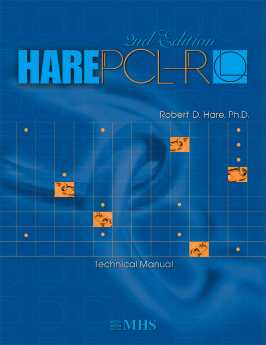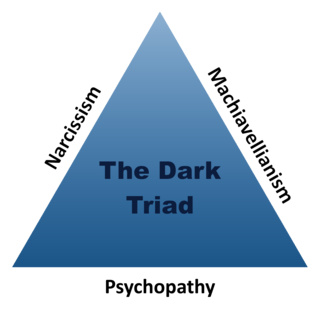Related Research Articles
Narcissistic personality disorder (NPD) is a personality disorder characterized by a life-long pattern of exaggerated feelings of self-importance, an excessive need for admiration and a delusional sense of status, diminished ability or unwillingness to empathize with others' feelings, and interpersonally exploitative behavior. Narcissistic personality disorder is one of the sub-types of the broader category known as personality disorders. It is often comorbid with other mental disorders and associated with significant functional impairment and psychosocial disability.

Psychology is an academic and applied discipline involving the scientific study of human mental functions and behavior. Occasionally, in addition or opposition to employing the scientific method, it also relies on symbolic interpretation and critical analysis, although these traditions have tended to be less pronounced than in other social sciences, such as sociology. Psychologists study phenomena such as perception, cognition, emotion, personality, behavior, and interpersonal relationships. Some, especially depth psychologists, also study the unconscious mind.
In statistics and psychometrics, reliability is the overall consistency of a measure. A measure is said to have a high reliability if it produces similar results under consistent conditions:
"It is the characteristic of a set of test scores that relates to the amount of random error from the measurement process that might be embedded in the scores. Scores that are highly reliable are precise, reproducible, and consistent from one testing occasion to another. That is, if the testing process were repeated with a group of test takers, essentially the same results would be obtained. Various kinds of reliability coefficients, with values ranging between 0.00 and 1.00, are usually used to indicate the amount of error in the scores."
The Minnesota Multiphasic Personality Inventory (MMPI) is a standardized psychometric test of adult personality and psychopathology. Psychologists and other mental health professionals use various versions of the MMPI to help develop treatment plans, assist with differential diagnosis, help answer legal questions, screen job candidates during the personnel selection process, or as part of a therapeutic assessment procedure.
The Liebowitz Social Anxiety Scale (LSAS) is a short questionnaire developed in 1987 by Michael Liebowitz, a psychiatrist and researcher at Columbia University and the New York State Psychiatric Institute. Its purpose is to assess the range of social interaction and performance situations feared by a patient in order to assist in the diagnosis of social anxiety disorder. It is commonly used to study outcomes in clinical trials and, more recently, to evaluate the effectiveness of cognitive-behavioral treatments. The scale features 24 items, which are divided into two subscales. 13 questions relate to performance anxiety and 11 concern social situations. The LSAS was originally conceptualized as a clinician-administered rating scale, but has since been validated as a self-report scale.

Narcissism is a self-centered personality style characterized as having an excessive preoccupation with oneself and one's own needs, often at the expense of others.
Malignant narcissism is a psychological syndrome comprising an extreme mix of narcissism, antisocial behavior, aggression, and sadism. Grandiose, and always ready to raise hostility levels, the malignant narcissist undermines families and organizations in which they are involved, and dehumanizes the people with whom they associate.
The Millon Clinical Multiaxial Inventory – Fourth Edition (MCMI-IV) is the most recent edition of the Millon Clinical Multiaxial Inventory. The MCMI is a psychological assessment tool intended to provide information on personality traits and psychopathology, including specific mental disorders outlined in the DSM-5. It is intended for adults with at least a 5th grade reading level who are currently seeking mental health services. The MCMI was developed and standardized specifically on clinical populations, and the authors are very specific that it should not be used with the general population or adolescents. However, there is evidence base that shows that it may still retain validity on non-clinical populations, and so psychologists will sometimes administer the test to members of the general population, with caution. The concepts involved in the questions and their presentation make it unsuitable for those with below average intelligence or reading ability.

The Psychopathy Checklist or Hare Psychopathy Checklist-Revised, now the Psychopathy Checklist—revised (PCL-R), is a psychological assessment tool that is commonly used to assess the presence and extent of the personality trait psychopathy in individuals—most often those institutionalized in the criminal justice system—and to differentiate those high in this trait from those with antisocial personality disorder, a related diagnosable disorder. It is a 20-item inventory of perceived personality traits and recorded behaviors, intended to be completed on the basis of a semi-structured interview along with a review of "collateral information" such as official records. The psychopath tends to display a constellation or combination of high narcississtic, borderline, and antisocial personality disorder traits, which includes superficial charm, charisma/attractiveness, sexually seductive and promiscuity, affective instability, suicidality, lack of empathy, feelings of emptiness, self-harm, and splitting. In addition, sadistic and paranoid traits are usually also present.

The dark triad is a psychological theory of personality, first published by Delroy L. Paulhus and Kevin M. Williams in 2002, that describes three notably offensive, but non-pathological personality types: Machiavellianism, sub-clinical narcissism, and sub-clinical psychopathy. Each of these personality types is called dark because each is considered to contain malevolent qualities.
Sexuality can be inscribed in a multidimensional model comprising different aspects of human life: biology, reproduction, culture, entertainment, relationships and love.
In psychology, grandiosity is a sense of superiority, uniqueness, or invulnerability. It may be expressed by exaggerated beliefs regarding one's abilities, the belief that few other people have anything in common with oneself, and that one can only be understood by a few, very special people. The personality trait of grandiosity is principally associated with narcissistic personality disorder (NPD), but also is a feature in the occurrence and expression of antisocial personality disorder, and the manic and hypomanic episodes of bipolar disorder.
In psychology, manipulation is defined as subterfuge designed to influence or control another, usually in a manner which facilitates one's personal aims. Definitions for the term vary in which behavior is specifically included, influenced by both culture and whether referring to the general population or used in clinical contexts. Manipulation is generally considered a dishonest form of social influence as it is used at the expense of others.
The Revised NEO Personality Inventory is a personality inventory that assesses an individual on five dimensions of personality, the so-called Big Five personality traits. These traits are openness to experience, conscientiousness, extraversion, agreeableness, and neuroticism. In addition, the NEO PI-R also reports on six subcategories of each Big Five personality trait.
The Psychopathic Personality Inventory (PPI-Revised) is a personality test for traits associated with psychopathy in adults. The PPI was developed by Scott Lilienfeld and Brian Andrews to assess these traits in non-criminal populations, though it is still used in clinical populations as well. In contrast to other psychopathy measures, such as the Hare Psychopathy Checklist (PCL), the PPI is a self-report scale, rather than interview-based, assessment. It is intended to comprehensively index psychopathic personality traits without assuming particular links to anti-social or criminal behaviors. It also includes measures to detect impression management or careless responding.
The Levenson Self-Report Psychopathy scale (LSRP) is a 26-item, 4-point Likert scale, self-report inventory to measure primary and secondary psychopathy in non-institutionalised populations. It was developed in 1995 by Michael R. Levenson, Kent A. Kiehl and Cory M. Fitzpatrick. The scale was created for the purpose of conducting a psychological study examining antisocial disposition among a sample of 487 undergraduate students attending psychology classes at the University of California, Davis.
Empathy quotient (EQ) is a psychological self-report measure of empathy developed by Simon Baron-Cohen and Sally Wheelwright at the Autism Research Centre at the University of Cambridge. EQ is based on a definition of empathy that includes cognition and affect.
In gender studies, the analysis of gender differences in narcissism shows that male narcissism and female narcissism differ in a number of aspects.
The Dark Triad Dirty Dozen (DTDD) is a brief 12-question personality inventory test to assesses the possible presence of three co-morbid socially maladaptive, dark triad traits: Machiavellianism, narcissism, and psychopathy. The DTDD was developed to identify the dark triad traits among subclinical adult populations. It is a screening test. High scores on the DTDD do not necessary correlate with clinical diagnoses.

In the field of personality psychology, Machiavellianism is a personality trait centered on manipulativeness, callousness, and indifference to morality. The psychological trait derives its name from the political theorist Niccolò Machiavelli, as psychologists Richard Christie and Florence Geis used edited and truncated statements inspired by his works to study variations in human behaviors. Their Mach IV test, a 20-question, Likert-scale personality survey, became the standard self-assessment tool and scale of the Machiavellianism construct. Those who score high on the scale are more likely to have a high level of deceitfulness and a cynical, unempathetic temperament.
References
- 1 2 3 4 5 6 7 8 9 10 11 12 13 The handbook of narcissism and narcissistic personality disorder : theoretical approaches, empirical findings, and treatments. Campbell, W. Keith., Miller, Joshua D. Hoboken, N.J.: John Wiley & Sons. 2011. ISBN 9781118093108. OCLC 784135838.
{{cite book}}: CS1 maint: others (link) - 1 2 van der Linden, S.; Rosenthal, S.A. (2015). "Measuring Narcissism with a Single Question? An Extension and Replication of the Single-Item Narcissism Scale". Personality and Individual Differences. 90: 238–241. doi:10.1016/j.paid.2015.10.050.
- 1 2 Vater, Aline (May 2013). "The Narcissistic Personality Inventory: A Useful Tool for Assessing Pathological Narcissism? Evidence From Patients With Narcissistic Personality Disorder". Journal of Personality Assessment. 95 (3): 301–308. doi:10.1080/00223891.2012.732636. PMID 23101721. S2CID 1920754.
- ↑ Raskin, Robert; Terry, Howard (1988). "A principal-components analysis of the Narcissistic Personality Inventory and further evidence of its construct validity". Journal of Personality and Social Psychology. 54 (5): 890–902. doi:10.1037/0022-3514.54.5.890. PMID 3379585.
- 1 2 Braun, Susan (17 May 2017). "Leader Narcissism and Outcomes in Organizations: A Review at Multiple Levels of Analysis and Implications for Future Research". Frontiers in Psychology. 8: 773. doi: 10.3389/fpsyg.2017.00773 . PMC 5437163 . PMID 28579967.
- ↑ Ackerman, Robert (2011). "What Does the Narcissistic Personality Inventory Really Measure?". Assessment. 18 (1): 67–87. doi:10.1177/1073191110382845. PMID 20876550. S2CID 11220300.
- 1 2 del Rosario, Peter M.; White, Royce M. (2005-10-01). "The Narcissistic Personality Inventory: Test–retest stability and internal consistency". Personality and Individual Differences. 39 (6): 1075–1081. doi:10.1016/j.paid.2005.08.001. ISSN 0191-8869.
- ↑ Foster, Joshua D.; McCain, Jessica L.; Hibberts, Mary F.; Brunell, Amy B.; Burke Johnson, R. (2015-01-01). "The Grandiose Narcissism Scale: A Global and Facet-Level Measure of Grandiose Narcissism". Personality and Individual Differences. 73: 12–16. doi:10.1016/j.paid.2014.08.042. ISSN 0191-8869.
- ↑ Miller, Joshua D.; Price, Joanna; Campbell, W. Keith (6 December 2011). "Is the Narcissistic Personality Inventory Still Relevant? A Test of Independent Grandiosity and Entitlement Scales in the Assessment of Narcissism". Assessment. 19 (1): 8–13. doi:10.1177/1073191111429390. PMID 22156716. S2CID 7440693.